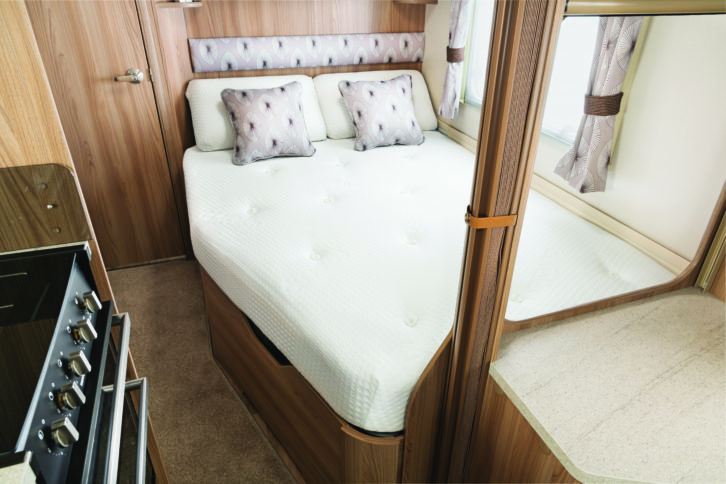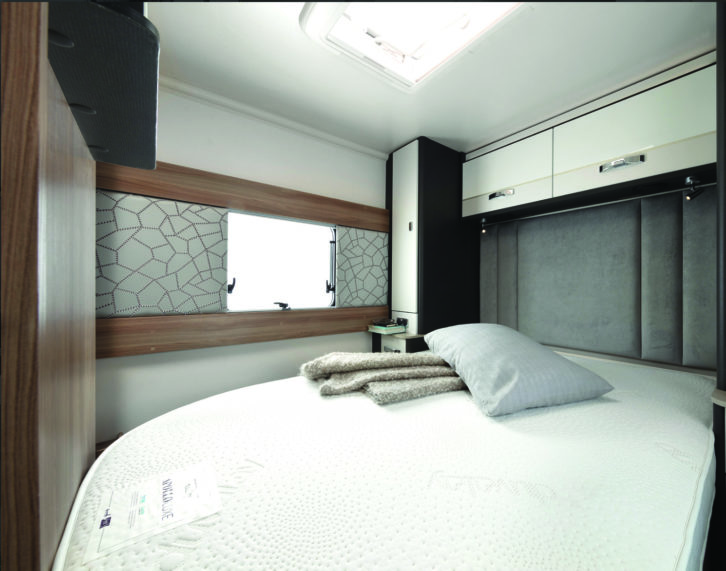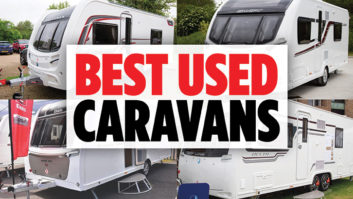Get the right bedding and mattress for a caravan. Read our Good Sleep Guide for top tips and buying advice
Getting a good night’s sleep and knowing how to make a caravan bed more comfortable can make or break a caravanning holiday. As well as lounging, cooking and washing facilities, one of the major factors (perhaps the most important?) in choosing a caravan should be that the sleeping arrangements are well suited to you and your family.
This will include the number of berths, bed types, size of beds and the comfort levels they provide. Getting the right mattress for a caravan will be crucial to comfort.
This guide outlines all of the aspects to think about, including buying bedding and a mattress for a caravan. Pus other useful advice to help you get a great night’s sleep in your caravan.
Practical Caravan is supported by its audience. When you purchase through links on our site, we may earn an affiliate commission. Learn more
Bedding and mattresses

Buying a mattress for a caravan – manufacturers
As caravan manufacturers have tried to differentiate their models from rivals’, the quality of the beds has become a focal point, with mattress brands such as Ozio and Hypnos joining their armouries. Companies such as Duvalay have upped the ante. Discerning customers demand higher-quality mattresses and toppers, recognising the huge importance of sound sleep.
Bailey
Bailey now offers larger beds in a range of styles, from huge make-up doubles to side and central fixed doubles in the rear of the tourer. Each range also offers a twin-bed layout.
The company fits memory foam-topped mattresses, and
its springy beech-slat bed bases increase levels of comfort, too.
Coachman
Luxury brand Coachman uses sprung construction upholstery. For its fixed beds, it provides high-quality, foam-construction mattresses, ensuring excellent levels of comfort.
Elddis
Elddis caravans come with fixed-bed mattresses that are lightweight and supportive. They feature soft-touch Argentum+ mattress fabrics which have antibacterial and anti-allergic qualities, based on silver-ion technology. Buyers can opt for a Hypnos mattress on fixed-double and twin-bed models.
Swift
Swift caravans have been fitted with Duvalay mattresses since 2014. When Duvalay technology was introduced, I had what I think was the best night’s caravan sleep ever, in a Swift Challenger. Today, the exclusive-to-Swift Duvalay Duvalite Apollo Luxe mattress has Freshtec, which Swift says is a high-quality foam, maximising airflow for a cooler and ultimately more comfortable night’s sleep. These mattresses are only available on fixed beds.
Bed options, sizes and mattress for a caravan

There are dozens of possible sleep options in a family caravan, so take the time to find the right one for you.
Make-up double beds in the lounge tend to be huge and reasonably comfortable. However, unless you’re caravanning in hot weather and can live outside until bedtime, you’ll need to deconstruct the bed every day to allow you to use the lounge. I am too lazy for all of those shenanigans and tend to opt for a fixed bed instead.
The other benefit of fixed beds is that they usually have bespoke mattresses made from high-quality memory foam, whereas in converted sofas, the cushions tend to be sprung or made with standard foam. Purpose-built fixed single beds will also benefit from being fitted with mattresses with better foam construction.
Children’s bunks and make-up beds, and bunks in dinette areas, will generally use a standard foam.
Bed size can be important and many French-style fixed doubles have significant cut-offs to allow for easier access to the washroom. These angled cut-offs do limit leg space, but I haven’t found them to be a major problem – and I’m 6ft 2in.
What can be more of a potential issue are fixed longitudinal double beds sandwiched between a central washroom and a van’s back wall. These often only measure 5ft 10in, so won’t allow taller caravanners to stretch out. In fact, if you are taller than 5ft 7in or so, you might find them a little restrictive.
The fairly new breed of 8ft-wide tourers has allowed manufacturers to fit larger beds as standard, and this is a real boon for caravanners. Just remember that the sheets and bedding might need to be oversized.
Extending transverse island beds slide back to allow easy access to the washroom in the day, and extend by a foot or so at night.
Replacement mattress for a caravan
Some after-market manufacturers will have the exact mattress measurements for your caravan’s bed on file, and a replacement in stock. However, it’s more likely you’ll have to measure your existing mattress and sketch it out, or fill in an online template.
Upgrading the base sections for the make-up bed in the lounge is trickier.
Check that the covers of the lounge’s sofa base and back cushions are removable and measure the length, width and depth of the foam filler inside, not the entire cushion. Of course, you’ll only need to replace the foam inserts of the cushions that make up the bed base.
Many mattress makers offer a custom service, cutting foams to any size and shape. This isn’t cheap: a good mattress for your van could easily cost over £400.
Linthorpe Beds is a good example of the services on offer, although several firms, such as those listed below, offer similar, where every mattress is made to measure.
Replacement mattresses for a caravan can be made in any size or shape you require. In foam or memory foam, or with open coil springs or pocket sprung. Remember to ask about warranties and delivery costs.
If you can’t get a replacement mattress from your van manufacturer, or you want to explore price options, these are just a few of the specialist firms in the market:
Custom Size Bed customsizebeds.co.uk
Duvalay duvalay.co.uk
Komfi komfi.com
Linthorpe Beds linthorpebeds.co.uk
Tockfield tockfield.com
Establishing good sleep patterns
Create a great space for sleeping
• Invest in a high-quality pillows and mattress for a caravan. This is relatively easy, although not always cheap for caravanners. But what value do you put on a night of sound sleep, and how much better that makes you feel the following day?
• Choose quality bedding, with the right Tog factor for the season, so that once you are asleep, you remain comfortable.
• Temperature is crucial to having sound, uninterrupted sleep. Research suggests that 18.3°C is the ideal temperature for good sleep. Although I’m pretty sure Mrs S would demand the Truma be turned up two or three notches! Find what works for you. Caravan interiors are ideal for closely monitoring and maintaining the internal temperatures, whether you have a blown-air or wet heating system.
• Too much light can disrupt your sleep and your circadian rhythm (the body’s sleep cycle). Modern caravans are a good environment for a black-out scenario.
• Create a quiet, peaceful environment. After about 10pm most UK campsites quieten down, creating a good sleeping environment. European campsites, I find, are often noisier until much later, as people abroad tend to eat and socialise later. Also consider the noises inside your caravan (pumps and boilers, and so on), and perhaps pack some earplugs.
• Pleasant aromas, such as lavender, are proven to help people sleep, and companies create scents specifically for the purpose. We’d always recommend choosing a diffuser rather than a lit candle (from a safety perspective).
Check out Neom or John Lewis for a range of soporific scents in reed diffuser form, or keep an eye on Aldi or Lidl, who also sell them at certain times of year.
Plan a sleep schedule
• Transitioning from work/home schedules to holiday ones can throw your sleep way out of kilter. Ideally, this transition should be a gradual process.
• Sleep scientists reckon you should have a target wake-up/get-up time and work back from that to discover your ideal bedtime, so that you can achieve your recommended amount of sleep each night. They also say that we should give ourselves extra winding-down time between the evening’s activities and going to bed.
• Too much napping during the day can cause problems with getting a proper sleep at night-time. Experts say a 20-minute post-lunch nap is the perfect solution.
Create a pre-sleep routine
• Poor pre-sleeping habits are one of the biggest contributors to disrupted sleep.
• Aim to create a consistent pre-sleep routine. This will signal to your body that you’re now approaching bedtime, allowing it to adjust.
• Using smartphones, tablets and laptops is not a good way to prepare for sleep. The light output minimises the production of the sleep hormone melatonin. Disconnect from all devices at least 30 minutes before bedtime.
• In addition, aim to wind down for at least 30 minutes before trying to sleep. Experts will suggest that you could do a few stretching or relaxation exercises, but listening to some soothing music (together or with headphones) or reading a book is probably more realistic and achievable for most of us.
• As you do these things, lower the lighting, because this is known to boost the production of melatonin. Modern tourers are ideal places to do this, because they have a plethora of lighting options and levels.
Plan your day for better sleep
• Exposing yourself to sunlight or natural light during the day is thought to regulate and normalise your circadian rhythm.
• Eating a large, fatty or spicy meal too close to bedtime can disrupt your sleep. If you feel you need an evening snack, aim to eat something lighter, such as cereal.
• Exercise is one of the best ways to promote good sleep. Changes in energy output and body temperature throughout the day are known to promote sleep. Cycling, swimming and brisk walking are three great ways to achieve this, but avoid doing them too close to bedtime.
• Caffeinated drinks, such as tea, coffee and cola, are great for a burst of energy, but can seriously disrupt your sleep patterns. Monitor your intake and avoid consuming them close to your bedtime.
Avoid hot chocolate and other sugary drinks before bed, because the sugar rush will undo any sleep-enhancing effects.
• Smoking is proven to be a factor in poor sleep patterns, making it harder to drop off and causing broken sleep.
• Alcohol is scientifically proven to lower sleep quality for most of us. If you suffer from consistently poor sleep, you should try avoiding alcohol before bedtime.
Things to think about
• Twin-bed caravan layouts have become increasingly popular for couples in recent years.As you get older, a good night’s sleep rises up the priority list. In addition, with more frequent visits to the toilet, or conditions such as restless leg syndrome, more caravanners will find their sleep affected. Not disturbing each other at night is a vital part of a harmonious lifestyle!
Twin-bed caravans are the ideal solution in this situation, especially because the toilet is close by in most rear-washroom tourers.
• Sleeping with your head a few inches above the heater unit or water pump is not the best idea, because they can cut in throughout the night.
If you’re a light sleeper, choose a tourer where your bed is positioned well away from the ancillaries, which are sometimes noisy. In the daytime, these sounds are masked by ambient noise, but in the quiet early hours, they become much more intrusive. This is mainly a problem when you use the make-up double bed up at the front, where the heating system is located under the sofa base.
• It’s easy to create a pitch-black environment, even when it’s still light outside. Sleeping in complete darkness is proven to be better for you, because it increases production of melatonin, which helps people to fall asleep faster and better.
The pull-down blinds on windows, and those that you can pull across roof vents, are simply brilliant for blocking daylight This will make your van one of the darkest places to sleep that you’ll find. This level of darkness might also delay your waking, giving you vital extra hours of sleep.
• If you require a low-level nightlight (for toilet visits), try to keep it at floor level and out of your line of sight as you lay in bed.
• I find the level of illumination from some caravan control panels and appliance LEDs far too bright – the interior can be bathed in a (usually) blue or orange glow, and once you’ve noticed, it’s hard to ignore.
Take some opaque tape or devise some other method to neatly cover the fridge and control panel lights, keeping the entire front bedroom area dark at night.
• In hot weather, caravan interiors can be uncomfortably warm, making it harder to sleep in at night. Try to create a cool airflow using a portable fan, or by leaving a window slightly ajar. If security issues are a worry, you could open a rooflight instead, although the cooling draught may not be as effective. Try to cool the van as much as possible before bedtime.
• Once in a while, you’ll find you’re pitched next to noisy neighbours. A polite “There are people trying to sleep here!” might work, but pack earplugs, just in case.
• As kids grow up, they get bigger, heavier and noisier. In such close proximity, earplugs could again be the best option.
There comes a time when caravan bunks just aren’t big enough and every time the kids turn over, they send a thud or thump through the whole interior. That’s the time to consider a bigger caravan. I know, I’ve been there!
• We’ve stayed at the occasional campsite close to a busy road (which rarely gets mentioned when booking). Check your proposed site on Google Earth or read reviews to see how close it is to noisy highways, rail lines or even flight paths – especially if you’re there for an extended period. That website will also help you to pick the best-placed pitches.
• External noise and internal heat is the worst combination for sleeping, because you can’t have the windows open due to the noise, so the heat builds up inside. Mosquitoes can have a similar effect. Once again, those small, cheap, foam earplugs might just be your sleep saviour.
• Make-up front beds require a little work to construct each evening. Care must be taken to ensure that the bolstered base sections are arranged the right way around. Otherwise you’ll have an uncomfortable raised bump sticking into your back.
• Many caravanners have found that foam toppers are a great way to eliminate any bumps or ridges in the sleeping surface of make-up beds. These can be quickly rolled out over the configured base cushions, before the sheet is fitted. While very comfortable, this requires no small amount of effort each evening. The topper will need to be stored somewhere handy. It might also take another 5kg off your usable payload.
• The comfier a mattress for a caravan is, the heavier it is likely to be! This isn’t generally a problem, unless you have a small payload or you need frequent access to the space under the bed.
Many higher-spec tourers are fitted with spring-assisted systems to lighten the ‘lift’ and hold the bed base in the raised position while you grab the items from below. Check this out on any new caravan before you commit to a purchase.
• Some caravanners like to change the mattress when they buy a pre-owned van, especially if it’s an older, well-used model. We list some custom-made, after-market mattress makers at the end of this article.
• Damp caravans are not healthy places to sleep, because mould and spores will often circulate in the air. Inhaling these particles can inflame your airways and cause congestion, chest tightness, wheezing, throat irritation and coughing. Prolonged exposure can even reduce lung function and result in chronic health problems such as asthma. Ensure that your caravan is serviced annually, including a damp test carried out by a qualified technician.
• If you have children, consider how the sleeping arrangements will work. If, for example, you want to stay up later and they need to go to bed. Smaller kids can be moved quite easily, bigger ones can’t. A second TV in the fixed-bed bedroom might be the solution.
• French-style fixed beds (usually with a cut-off section and one occupant next to the wall) can cause problems if that occupant needs to get up in the night. They will inevitably disturb the person they have to clamber over in the dark. This is an important consideration when choosing your caravan layout.
• Carbon monoxide (CO) is an invisible killer, so we always leave some form of ventilation ajar, even in colder weather. That might be a roof vent or a window.
CO detectors/alarms have been obligatory in caravans sent for NCC certification since 1 September 2011. All new tourers should have a Type B CO alarm that complies with BS EN 50291.
If you buy a used caravan, bear in mind that CO alarms have a typical lifespan of five to seven years. Yours might well need replacing.
Likewise, you should also change the batteries in the alarm every six months. Check that the unit is tested as part of your annual service. You’ll sleep all the more soundly for doing so!
If you’ve enjoyed reading this article, why not get the latest news, reviews and features delivered direct to your door or inbox every month. Take advantage of our brilliant Practical Caravan magazine SUBSCRIBERS’ OFFER and SIGN UP TO OUR NEWSLETTER for regular weekly updates on all things caravan related
One benefit of fixed beds is that they usually have bespoke mattresses made from high-quality memory foam






